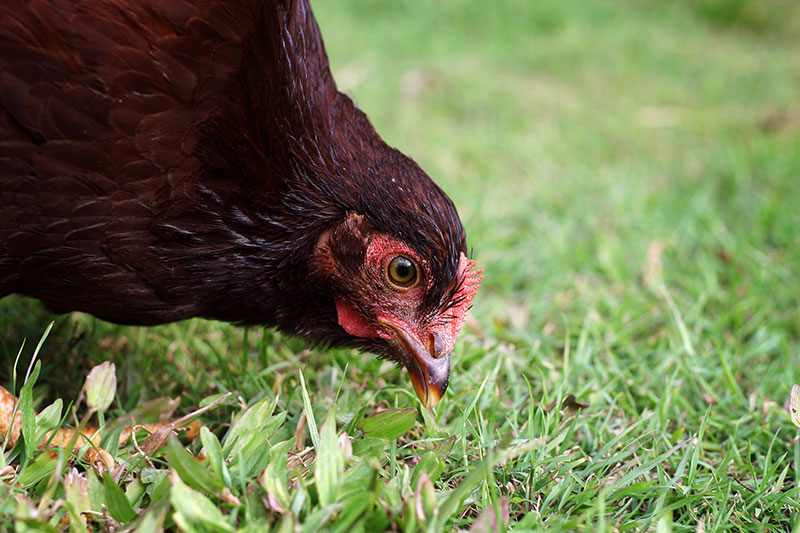
It happens to every chicken-keeper at some point. Maybe you get caught up in an all-consuming project at work or around your farm or home. Perhaps you simply misjudge your inventory. Quite possibly, the child in charge of this chore simply fails to notice. Whatever the reason, you’re now in a bit of a predicament: You’ve run out of chicken feed.
You’re at a loss, but don’t kick yourself too hard. After all, reality happens. Rather than letting it happen repeatedly, improve your organization. Try one of these memory tips.
- Keep a white board someplace very visible (by your refrigerator, for instance) and write notes in big, eye-catching letters such as “HALF A SACK LEFT!”
- If your child fills your feeders, teach him or her a simple trick to recognize when it’s time to buy more rations. These include seeing the bottom of the bag or container when scooping feed, accidentally hitting the bottom when doing the same, or noticing that the container is very light when it’s lifted.
- Mark the six-inch line on a ruler or yardstick with a permanent marker, then insert it into your feed. Buy more food when you can see that line again.
That’s for the future. What’s important when you run out of chicken feed are the hungry birds eyeing you expectantly, wondering where dinner is. If it’s after hours and the farm-supply stores are closed, what can you do?
First, don’t panic. If your feed sack just went empty, there’s probably enough in the feeders for the final few hours of the day. Once dusk hits, your birds want to roost, not eat. Set your alarm very early and get to the feed shop as soon as it opens. If there are more than a handful of hours until dusk, though, you need other sources to keep those bird bellies full until you can get to the store. Try one—or several—of these six quick fixes to keep you covered until then.
1. Ask Other Chicken-Keepers
If you live in a chicken-friendly neighborhood, one of your neighbors probably keeps a backyard flock, too. If you know such a neighbor, ask whether you can borrow or buy some chicken feed from them.
2. Have Your Chickens Find Free Food

A number of chicken breeds, such as the Plymouth Rock and the Rhode Island Red, forage extremely efficiently, converting wild greens, seeds and insects into fuel. If you can safely—and legally—release your chickens, let them forage for a few hours. The more manicured your yard is, the less of a chance your birds will find bugs, dandelion leaves and the like, but a little grazing beats no grub at all.
3. Feed Select Kitchen Scraps

Your kitchen discards can serve as dinner for your feathered friends, especially if you keep a crock or tub for compostable material. Fruit peels and cores, vegetable trimmings, stale bread and similar rejects make a bounteous meal for your birds. Add some leftovers from your refrigerator, and your flock is set until the regular feed resumes the next day. Just make certain your offerings do not contain uncooked potato peels, avocados, coffee grounds, chocolate or spoiled food. These are dangerous to poultry when ingested.
4. “Recycle” Eggs

Eggs nourished your chickens in their early stages. They can certainly nourish them for one day if you run out of chicken feed. You might have already packed a couple of dozen to sell or give to friends but, right now, your chooks need them more than your customers do. Plan on a minimum of two eggs per bird, then scramble them (withholding all seasoning). Your girls will especially appreciate this protein boost, as hens tap into their own bodies’ protein levels to fuel egg production. If you plan to feed your flock the eggshells as well as the eggs, make certain to thoroughly wash the shells to remove all traces or albumen and yolk, then grind them up in a food processor. In short, make them as unrecognizable as possible so your birds don’t start helping themselves to what’s in their nests.
5. Poultry Porridge
Many chicken-keepers who live in northern regions prepare a hot breakfast mash for their chickens on chilly winter mornings. It might not be cold outside, but the option of a poultry porridge still works if you run out of chicken feed. Oatmeal (not the flavored, instant kind), cornmeal, grits, quinoa, bulgur wheat—any whole grain works for your flock. Make the consistency thinner than you do for human consumption, withhold seasoning, and let it cool to room temperature before serving it to your birds. Dole this out in ladle-size portions around the run to prevent crowding at this delayed dinnertime.
6. Treat Time

Scratch is typically viewed as chicken candy, offered infrequently as a treat (or as incentive to dig in designated areas). Given a choice between layer rations and scratch, your birds will go for scratch every time. Because it does not provide the essential vitamins and minerals necessary to nourish to your flock, never use scratch as a main food source. However, when you’re out of regular feed, scratch is better than nothing.
Note that these emergency feed measures should in no way replace nutritionally balanced feed. Without the proper percentages of proteins, carbohydrates, vitamins and minerals, your chickens do not develop healthfully, and egg production suffers. Your best bet? Next time you go to the feed shop, pick up an extra 50-pound sack and keep it stored away so you never again run out of chicken feed.





